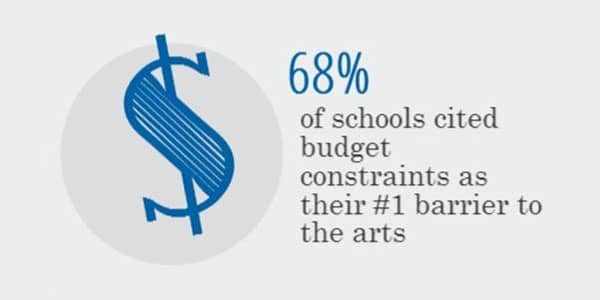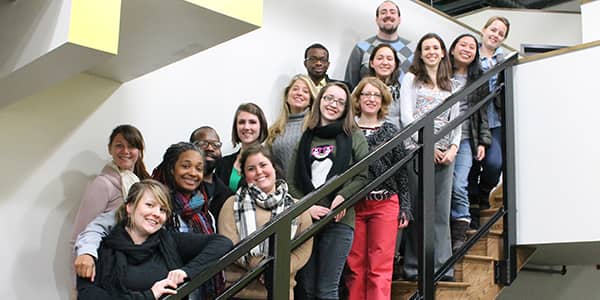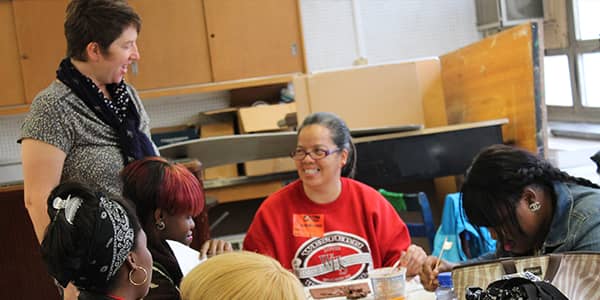Blog
More funding info for schools now online
In response to feedback from our school partners throughout the state, Young Audiences has expanded the resources available on its website for schools and community organizations looking for additional funding opportunities to bring valuable arts experiences to Maryland students.
In preparation for our five-year strategic planning process, Young Audiences conducted community interviews with leaders in education, arts and culture, philanthropy, business, government, and higher education. We also surveyed our current school and community organization partners, as well as those schools we have not partnered with in recent years. These surveys and interviews helped us understand what thought leaders in our field see as the biggest challenges in education and how our community views the role of the arts, artists, and Young Audiences in the education of our children.
Here were some key findings:
More than three-quarters of our surveyed partners said they would like to increase the amount of Young Audiences programming in their schools! Our school partners are also more aware of the array of arts-integrated programs Young Audiences offers, such as professional development workshops for educators.

While both partners and non-partners alike believe in the importance of arts-in-education programs, many schools said that barriers to the arts still exist–the most prohibitive being cuts to school budgets. Half of the surveyed schools noted that their discretionary funds for arts/cultural programs from outside providers have decreased. Many of our partners suggested that Young Audiences offer additional grant opportunity information, so we have compiled an even more comprehensive list of grants and resources for schools. Visit our website to take a look!
Despite these financial obstacles, we found a promising consensus that the arts play an important role in the education of Maryland students and in meeting educational priorities.

Young Audiences partners with several generous individuals and foundations to make our programs accessible. While many of our donors have specific sites that they wish to sponsor, if you are in need of funding to bring one of our programs to your area, please contact us at (855) 245-2787. We may be able to help.
The Artist is Present
By Kevin Adekoya, Young Audiences Development Assistant

This month, 51 artists and teachers completed their final Reflection Day of the 2013-2014 Teaching Artist Institute (TAI) Seminar. During the past five months, artist and teacher pairs have worked together to create new arts-integrated assembly and residency programs that will engage students in learning through the arts. To celebrate this accomplishment, one Young Audiences staff member shared his thoughts on TAI and what is possible when artists and classroom teachers work together to improve education.
Witnessing collaborations between artists and teachers during the Teaching Artist Institute (TAI) Seminar is like getting a behind-the-scenes look at how artists think and operate. There is a circus of artistic expression in all its forms—music, dance, theatre, and visual art—all with the power to inspire and beguile. During the past five months, carefully-crafted performances and interactive arts activities co-created by participating teachers and teaching artists have become new assembly and artist-in-residence programs for students in Maryland. Each program shows the deep personal commitment of each participant to educating students throughout the state.
It was just a few short months ago when these artists and teachers from across the region met at City Neighbors High School for the TAI Presentation Workshop. Each artist and classroom teacher partner was present to share their plans for an arts or STEAM (Science, Technology, Engineering, Arts, and Mathematics) program. Different classrooms throughout the building were devoted to different art forms so participants could present their lesson plans to their peers for feedback. Within each room you saw groups of people listening intently as each artist and educator explained their plans and how their approach would help students connect to the curriculum in a new way.
In each room hands shot into the air to provide praise, ask questions, and suggest new ideas—all in the name of creating innovative arts-in-education programs that will inspire and excite students. Feedback, given freely between artists and educators, formed a bond that was tangible. Everyone’s focus was on finding ways to address the curriculum through the stimulating lens of the arts.
One of my favorite moments was being able to participate in a sample lesson from the residency “Culture Kingdom Time.” Jessica Smith, founder and lead teaching artist of Culture Kingdom Kids, is the Culture Queen who, through interactive song, dance, and movement, highlights historic African American role models for fifth graders. For example, Barbara Hillary, who became the first African American woman to reach both the North and South Pole at the age of 79. Or York, who, with Lewis and Clark, journeyed to unchartered western territories of the U.S. from 1804 to 1806. These stories and others connected with what students were learning in History class and focused on themes of overcoming obstacles–something all students can relate to on a personal level. Throughout her lesson, Jessica’s goal was to show children that they too could be future pioneers by remaining curious and pushing beyond their comfort zones.
Young Audiences brings together skilled professional artists and classroom teachers to create programs that combine the knowledge and expertise of both parties. By integrating the arts into the curriculum, teachers are able to engage students with curricular content and artists are able to tap into a student’s true potential. What a great experience it was to take part in!
Young Audiences has a new home!

We started 2014 off big: moving into a brand new space in the restored former tire shop at 2600 North Howard Street in Remington.
Everyone has been talking about our big move (the Baltimore Sun recently featured the new development), but we want to give you a firsthand look at what’s really going on inside our spacious new home. Check out this short virtual tour for a glimpse into our new offices, and a look back to how far we’ve come since the organization’s start in 1950!
[youtube http://www.youtube.com/watch?v=LkL6Jgh-ggE]
Come see us in person at our Open House event on Sunday, February 16, from 1 to 3 p.m. There will be Young Audiences staff and roster artists on hand to provide interactive and artistic entertainment as well as impromptu tours of the space. The whole family is welcome! RSVP here if you plan to attend. Stay updated on the schedule of events and entertainment by joining the Facebook event.
While you’re here, you can also see our neighbor (and roster ensemble) Single Carrot Theatre‘s final matinée performance of “The Flu Season” at 2:30 p.m. Learn more about the show and buy your tickets online. Discounted tickets are available for $10 by using the coupon code YAMD. Tickets are expected to sell out quickly for this final show, so please purchase your tickets early! (Please note: This particular show is best suited for theater-goers 18 years and older.)
Not able to make it on February 16? Sign up for one of our monthly On the Bright Side tours to see our new space and learn about our programs and their impact on Maryland students. You’ll get the chance to talk with one of our teaching artists, our executive director, and a member of our board, all while learning more about our work of bringing the power of the arts to Maryland students and educators.
Hope to see you soon!
Making our mark on history with art
By Nadine Elsigal, senior at Western High School

As a senior at Western High School I had the privilege of being involved in a clay mural project with Young Audiences artist Amanda Pellerin in October. Working with Ms. Amanda during the residency was such a pleasure because clay is a medium I don’t often get to use in my art classes at Western. This project was new territory for me since most of my school projects are created digitally and working with clay was an opportunity to get more hands-on. I feel that art is a crucial element to a person’s development that is often overlooked, but projects like the mural we created with Ms. Amanda really gave back to the students and allowed us a chance to create. Art is a big part of my life and I plan to pursue it as my career. This residency was also a chance for me to learn about Young Audiences, an organization that shares my belief in the importance of the arts in learning.
Seniors from both my graphic design class and a history class worked with several Western alumnae and Ms. Amanda throughout the project. We decided to create a visual timeline of our school’s history to celebrate Western’s 170th anniversary this year. I knew little about our school’s rich history at the start of the project. We worked as a team to delve into past yearbooks and brainstorm with alumnae to decide on the imagery we would include in the final piece.
I decided to recreate our senior class T-shirt design in my clay tile to represent current Western students. Including a symbol of our class in the mural was a chance to leave behind a piece of the Class of 2014 within an artwork that will hang at our school for years to come.
View all three pieces of the finished mural, as well as photos of its creation, online.
As hard as it is to choose my favorite part of the residency, I think I enjoyed hanging the finished mural the most. There isn’t a better feeling than seeing work you have created put on display. It made me realize that I had done it–I overcame the challenges of the project and created something that current and future students will enjoy. I feel proud to have been a part of this residency and to have successfully completed such a large project that can be shared by my school community.
At the start of the residency I was excited–I thought the project would be fun and a great opportunity to leave our mark on Western. Now that the mural is complete and installed I feel accomplished. As I finish my last year at Western, I will graduate knowing that I added to my school’s long history.
Creating confident students–and future leaders–through the arts
By Micaela Gramelis, Young Audiences Grants and Annual Gala Manager and former teacher

Sitting in my class each day, Nadia did well. She worked hard; she smiled. She was kind, but deferred to her third-grade classmates for academic guidance during group activities. After the first half of the school year I would not have described her as a leader. Boy, was I wrong.
Nadia’s gift spent months undercover in our classroom. It was not until the class held a talent show at our pre-spring break celebration that a brave, confident Nadia emerged. As Nadia’s group began their rehearsed dance for the audience, her dance partners—both confident learners who often directed activity in the classroom—lost track of the dance sequence. All eyes turned to Nadia, whose poise and confidence in her movements indicated to her classmates that she was the one they should look to; she was the one they should follow.
During the two years I spent teaching in Baltimore City Public Schools, my students were aware of what was out there. They knew of museums, universities, and instruments, even if they did not utilize these things in their day-to-day lives. These artistic tools and institutions–so cool at first–quickly lost their appeal when my students thought that they were inaccessible. Consistently kept at a distance, they became the enemy and symbols of what one lacked.
Nadia was fortunate to discover her connection to dance outside of the classroom, despite not having access to dance classes at her school. Nadia’s visual arts classes often consisted of coloring with crayons and pasting one color of construction paper on top of another when she was lucky—but a student’s access to the arts should not be up to luck. Artistic opportunities in school are about much more than cultivating fine motor skills and identifying artistic talent; they are about closing the gap between what students know exists, and what they have been conditioned to believe is out of their reach from years of deprivation.
Nadia and her classmates did have the opportunity to play recorders in their music class, and the pride with which they carried their recorders down the hallway let me know that these instruments were prized possessions. When my students held their own recorders, with their names attached, the arts became tangible; they began to move forward, one step, toward what they deserved. When they performed in our talent show, and were cheered on by siblings, parents, and classmates, my students nudged forward toward what they deserved. When they wrote plays, and their written words were enthusiastically acted out by their peers, read aloud and valued by others, they began to experience how the arts can create a community and boost the self-esteem of each class member. Our students deserve this community. They deserve the opportunity to try new things. They deserve positive attention for their accomplishments, and for their voices to be valued. This is all possible through the arts.
To ensure that each Maryland student has the opportunity to experience the power of the arts, Young Audiences has increased its presence in Baltimore City schools from 89 schools to 119 schools during the last four years. In 2009, we served 22,033 students; in 2013, we served 38,317. Since its launch in the winter of 2009, our Access for All Initiative has subsidized programs for students in low-income Baltimore City schools to ensure that all students have equitable access to the best artists and educational arts experiences that our state has to offer.
Inequity in access to the arts is just one manner in which many of our students from low-income backgrounds are underserved. Increased access to the arts will not solve every challenge of poverty, but it can produce empowered leaders—equipped with resiliency, creative thinking, and problem-solving skills—who are prepared to tackle future challenges. It will produce youth who have learned to value their voice because they have had the opportunity to share it with others. It will produce students who know what they deserve, and have the tools they need to put up a fight for it.
If you are interested in applying for a Spring 2014 Access for All grant to bring a Young Audiences program to your school, the application is available online here. To learn more about Access for All and our work to increase equity in arts programming, click here.
Tube Beat or Not To Be? Discovering Sound through Rhythm and Movement
By Max Bent, Musician and beatboxer

Young Audiences artists and teacher partners have written case studies documenting their work in schools and their exploration of one essential question. Each study provides a snapshot of how the artist or teacher works with students to integrate the arts into the curriculum and provide opportunities for students to imagine, create, and realize their full potential through the arts.
Project or Program Summary
I first experienced beat tubes (capped PVC tubes that produce distinct pitch) while playing in the ensemble of fellow Young Audiences artist Kevin Martin. Inspired by their simplicity and immediate impact on students, I worked with a team of fifth- and sixth-grade teachers to design an arts-integrated beat tube residency. Our team began with the essential question “What is sound?” Through interacting with and playing the beat tubes, students experienced the propagation of sound while applying principles of music and dance during a culminating group performance.

Purpose and Rational
Beat tubes offer a wealth of possibilities for further exploration of arts-integrated teaching. As an instrument, beat tubes are linked in heritage to Tamboo Bamboo in Trinidad as well as numerous folk music traditions surrounding the pounding of grain into flour. This case study is submitted in the hopes of inspiring other educators to experiment with beat tubes.
Analysis and Outcomes
What are your overall conclusions regarding the documentation gathered for this case study?
Students learned that the phenomenon of sound can be understood as patterns of vibration through a medium–usually air. These patterns of vibration are called “sound waves.” “Pitch” and “volume” are aspects of sound waves that can be manipulated by musicians to express ideas and feelings.
What conclusions have you drawn from the responses to the assessment tools you have developed?
Students gained new insights into the phenomenon of sound. Students also improved their ability to work together cooperatively and to communicate in a collaborative setting.
Back to the initial inquiry question, can it be answered?
Yes. After the residency, students were able to identify and discuss specific scientific terms related to sound (i.e. frequency, amplitude, wavelength) and use this knowledge to enrich their compositions.
Playing the beat tubes connected body and mind in the practice of music. Students learned to play rhythmic patterns on steady beats but the challenge was both physical (kinesthetic) and mental.
Summary and Conclusions
What was learned?

By playing the beat tubes, students were able to objectify the often confusing and mysterious nature of sound. Students were able to approach the inquiry question scientifically.
Students learned:
- Sound is a phenomenon that our brains perceive and process in a specific, predictable way.
- The physical characteristics of sound are frequency and amplitude.
- The frequency of a sound wave is defined in musical terms as pitch.
- Different pitches form melodies and harmonies, both of which can be defined mathematically through interval relationships.
What can be done differently in the future?
I introduced the residency with beatboxing (vocal percussion) activities during the course of three days. In the future, one day of beatboxing would suffice. This would allow more time for working with the beat tubes and further discussion and analysis of the scientific principles of sound.
I would have liked to give students more time to compose independently. Also, students can potentially be involved in the construction of the beat tubes in the future.
How will this inform the work moving forward?
This project inspired me to expand the possibilities of working with beat tubes. Specifically I learned that vocalizations and movement are essential to successful instruction. Therefore I will explore the elements of dance as well as other related musical traditions (i.e. drum lines, West African drumming) to improve the project. Overall, I was amazed at the possibilities of working with beat tubes.
Curriculum Connections
Music
Science
Dance
21st Century Skills
Learn more about Max’s assembly, residency, and professional development programs.
Read other case studies written by Young Audiences teaching artists and teacher partners.
Bomani and students use poetry to address bullying

Young Audiences Hip Hop poet Bomani recently visited Empowerment Academy Elementary/Middle for an assembly and workshop to teach students the elements of writing Hip Hop music and its parallels to poetry- and essay-writing while also addressing the subject of anti-bullying. Following the assembly, Open Mic, students worked with Bomani to use the techniques demonstrated in his performance to write their own Hip Hop poem about how to handle bullying inside and outside of school. One teacher shared: “Students were pleasantly surprised at their ability to write poetry, and became more adamant about stopping bullying.”
The assembly and workshop were made possible through the Young Audiences Access for All Initiative which makes Young Audiences artists and programs available to high-need Baltimore City Public Schools at up to 80 percent off of the cost. This opportunity helps principals with limited resources provide hands-on learning in the arts that supplements and enriches the curriculum.
The following day, three students volunteered to share their finished poem with the student body over the school intercom. Read the full poem below!
No Bullies!
When there is bullying, don’t just be a bystander,
Better not mess with a Marylander!
Find an adult who is trustworthy,
So the bully will not continue to hurt me!
There is verbal, physical, cyber, and exclusion,
Don’t do any of these. Use inclusion!
Bullies cause a lot of confusion,
Everyone must help to find a solution!
This is just one example of how Young Audiences artists connect fine arts, the curriculum, and important 21st Century skills to impact how students see themselves and relate to others.
Learn more about Bomani’s assembly and residency programs here!
Uncle Devin shares TAI residency success!
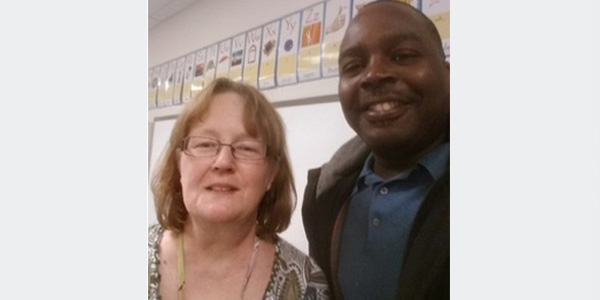
For four days in November, it was my pleasure to conduct an artist-in-residence program with a first grade class at Germantown Elementary School in Annapolis. The program was my field test that I am required to complete as a student of the Teaching Artist Institute (TAI), developed by Young Audiences, the Arts Education in Maryland Schools Alliance (AEMS), and the Maryland State Arts Council (MSAC).
TAI is a comprehensive professional development program for teaching artists that builds the artists’ capacity to contribute to student learning in and through the arts. The program trains teaching artists in the use and understanding of the state curriculum and the Common Core Standards, as well as arts integration strategies to assist the artist in engaging teachers and students.
Through TAI, I was paired with Judith Pirela, a first grade teacher at Germantown Elementary School and, for four days (at least 45 minutes per class), I went into her class to test my residency plan entitled, “The World of Percussion!” After developing my residency plan, I then had to develop four separate lesson plans. My four days of lessons taught children how:
- To classify classroom instruments by sight and sound, such as wood blocks, triangles, rhythm sticks, maracas, guiros, jingle bells, sand blocks, cymbals, tambourines, and hand drums;
- To compare musical sounds (i.e. fast/slow, loud/quiet, long/short, high/low);
- Different cultures created codes to communicate through beats and rhythms; and
- To make their own percussion instruments.
It was great working with Ms. Pirela, her students, and all of the staff at Germantown Elementary School. I want to also thank TAI Music Specialist Sue Trainor, who guided me through the entire process and provided me with excellent feedback. The TAI program ends on February 1, 2014 with a Program Evaluation and Reflection event, at which time I hope to become one of the newest graduates of TAI.
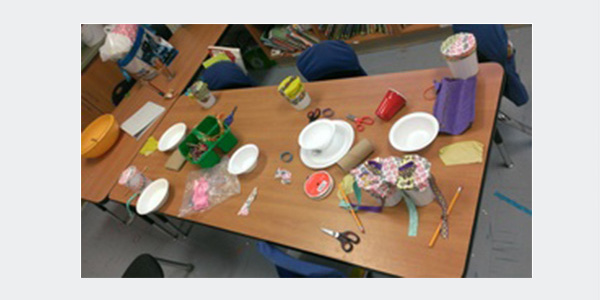
Read the rest of Uncle Devin’s December enewsletter here. You can learn more about Uncle Devin on Young Audiences’ website and at www.theuncledevinshow.com.
I am an artist
By Colette Krebs, sophomore at Annapolis High School’s Performing and Visual Arts Magnet Program
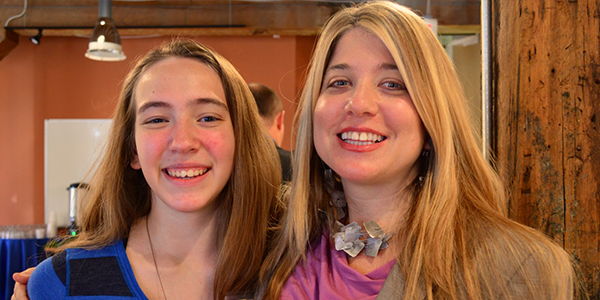
I want you to think of your life right now. Think about who you work with. There may be that one person who loves movies or sports or drawing. Everyone you work with, you put a label on. Not necessarily bad, just who they are in your mind. That girl over there, she’s a reader. You, you are a church goer. We all label people and we’re all labeled.
My name is Colette Krebs. I am 15, a sophomore in the Performing and Visual Arts Magnet Program (PVA) at Annapolis High School in Anne Arundel County.
If you asked me what my life would be like without art, my answer would be simple. Empty. It would have to be because I can’t remember life without it.
From my first memories of school –including preschool at Creative Gardens—the arts have always been part of what I do. I’m speaking today because I want you to know the impact art can have.
Before art was seriously introduced in my life in the Wiley H. Bates Middle School PVA program (I was in the first year of students to attend), I was a bit of a loner. That was my label. I was the girl who would spend lunch reading Harry Potter rather than hanging out with friends.
In PVA, work was collaborative, so you became vulnerable as you opened up. Through this process, especially in theatre, I was able to communicate better, I made friends, and I learned ways that art can be used to succeed outside of art classes.
All of my classes, even science and even math, were arts integrated. One of my favorite memories was in my eighth grade geometry class. We were drawing a city landscape, keeping the buildings proportionate with geometric measurements. Young Audiences made that moment possible by training our teachers and by providing professional artists who came into the school to teach us.
In theatre, when we are given monologues, we are only given a part of a character and we have to fill in all the details. So when it came to science and math, where my classmates struggled, I had no issue memorizing the vocabulary and formulas, analyzing situations, and finding creative solutions.
My arts training also taught me how to work under pressure, which really helped me with homework. I am in school from 7:17 a.m. until 4:45 p.m. because of the extended arts day. And, until recently, I added even more time, as I played a dynamic role in Electra so I couldn’t start homework until 8:00 at night.
Unlike many of my art friends, I wasn’t aggressive in getting the lead, I wasn’t emotional about relationships or projects or Angelina Jolie. I preferred to stay inside my head, making observations, but PVA didn’t allow me to do that. It pulled me straight out of my shell. At first, I felt scared; I had been yanked out of everything I’ve known in front of complete strangers, but almost immediately, I loved it. These weren’t regular kids, these were artists. Loud, obnoxious, funny, opinionated, rambunctious, and everything else you could want in a friend. I didn’t want to go back to the way it was and they certainly weren’t about to let me.
It has always been my dream to grow up and incorporate the arts in my life, but I thought it was black and white. I could dance, sing, act, or be an artist.
But art isn’t about exactness. In art there are a lot of gray areas that you get to fill in with all the colors of the rainbow, pirouettes, and C major chords.
When you experience art, something changes inside you and all of a sudden, you’re able to see the world in a new way.
I found my own way through life with the help of art, the support of my parents, Bates and Annapolis, and Young Audiences. Without this, I wouldn’t be here today. I know that I am lucky to have these experiences and I hope that through Young Audience’s work, many more kids will be just like me: building their dreams around a future that is hopeful. I don’t know what my future holds, but I know that with art it will be beautiful and full of hope.
When I was young, I was labeled a loner. Now that I’m older, I’m proud to say that I’m not a loner. I am an artist.
Colette shared how the arts have affected her life inside and outside of school at Young Audiences’ Impact Breakfast in November.
Hip Hop and History: Telling Stories of the Past and of Ourselves
By Staci Taustine, Fifth Grade Teacher, F.L. Templeton Preparatory Academy

During the course of my fifth-grade class’ six-day Hip Hop residency with Young Audiences artist Jamaal “Mr. Root” Collier, walls were broken down, confidence was built up, and the entire context of my classroom changed for the better.
As an educator I work hard to provide my students with diverse learning opportunities that give each child a chance to shine. However, I did not anticipate how effective Mr. Root’s strategies would be for the many different types of learners in my class. I went into this experience hoping that Mr. Root might be able to give a fresh perspective that would help my students summarize and internalize autobiographical texts. By the end of the residency, I knew that my students gained abilities far beyond that, having learned more deeply about how they express themselves and their story along the way.
Our time with Mr. Root began with an interactive assembly where he introduced the history of Hip Hop and taught students about the five components of this complex art form. Mr. Root motivated students by giving them the opportunity to participate in making beats and validated their contributions by recording and using their input right there on the spot. The students cheered and looked on as he mimicked some of their favorite Rap musicians.
The real magic happened when Mr. Root returned to our classroom and engaged with the students in a more intimate setting for a series of workshops. In a classroom of 20 students he quickly learned everyone’s name and became part of our classroom community. The kids shared with him that we were reading “The Narrative of the Life of Frederick Douglass” and he began to teach them how to summarize the content through the use of rhyming couplets. This strategy challenged students to return to the text over and over (an academic demand that is typically frustrating to them) to fish out the most important information. They reflected on the value of certain facts and determined which details could combine to most effectively summarize the text.
Together the class wrote a rap that brought the story of Frederick Douglass to life. It was truly amazing to see students who are usually self-conscious about participating come to the front of the room to offer input on better ways to write a line or to question if the number of syllables in a line would be best for the flow of the rap. The class later performed their work for the whole fifth grade during our culminating assembly at the end of the residency.
This was their final product:
Frederick Douglass was born a slave
Maryland-born he knew to be brave
1817 when he was born
When his ancestors left him he was torn
Owned and leased by several masters
Forced to work he had to work faster
Thought they were happy when slaves sang songs
But they sang about pain… Slavery was wrong!
After discussing the components of autobiographical writing in reference to our work with Frederick Douglass, we turned our focus to the need to know oneself in order to write an authentic autobiography. Students shared that sometimes people act certain ways to get attention but this behavior doesn’t necessarily accurately represent who they are as a person. Students brainstormed a number of ways that people wear “masks” on a daily basis to cover up how they are really feeling or to alter the way that the world perceives them.
Mr. Root led the students in an essay-writing exercise about how the “masks” each of them wear impact their relationships with others. Each student considered what they wanted to show the world through their actions and their autobiographical writing. To accompany their essay, students also created actual masks with construction paper, which were proudly displayed at the school-wide literacy fair in October.
In the end, my students learned how to be vulnerable with one another, brave enough to share their feelings, and empowered to use their voices to express everything they learned. Whether through singing their Frederick Douglass rap, expressing their ideas visually with their masks, or by simply having the confidence to think creatively, each and every one of my students came away with a unique perspective on who they are as individuals.
Going forward, I am excited to continue incorporating the components of Hip Hop to benefit my students’ learning and I am so pleased with this incredible learning experience. Thank you, Mr. Root!
Learn more about Jamaal “Mr. Root” Collier’s assembly and residency programs here!
Using arts integration to prevent summer learning loss
By Lucy Coyle
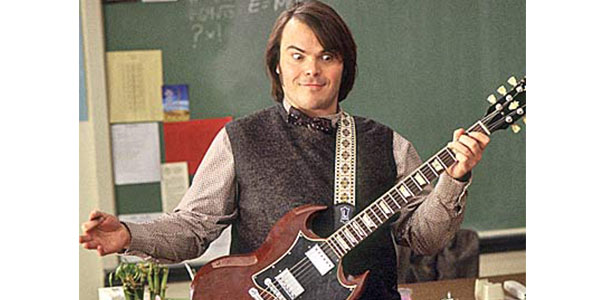
Lucy Coyle recently completed a summer internship at Young Audiences and wraps up our series on Young Audiences’ summer learning programs–and their importance for students who would otherwise have limited opportunities to stay active and engaged during the summer months.
If you’ve seen Jack Black’s teacher impersonator role in the comedy School of Rock then you’ve seen a glimpse of how the arts can engage students in the classroom. In one memorable scene during the movie, Black sings to his class about fractions to come across as a productive and innovative teacher. While in Black’s case the fractions song is all part of a larger scheme to teach students how to rock and not about math, putting mathematic equations to melodies is certainly one way to engage kids in the subject. If you, like me, learned the song “Fifty Nifty United States” at any point in your adolescence–and can still recite all of the states in alphabetical order–you know that arts engagement works.
I had the pleasure of visiting a Baltimore City Public Schools Summer Learning Academy classroom this past July and experienced much more than arts engagement–I saw arts being integrated into the curriculum. Young Audiences again partnered with Baltimore City to provide rising fifth- through eighth-grade students with arts-integrated learning opportunities during the summer months. Through generous funding provided by the Hoffberger Family Philanthropies, Young Audiences was able to expand its role at 10 Summer Learning Academy sites to provide arts enrichment sessions and arts-integrated math and STEM lessons at each site. During my visit to William Pinderhughes Elementary I witnessed how impactful arts integration and summer learning can be when combined.
Young Audiences artist Arianna Ross is a champion for arts integration. She’ll tell you openly that “it’s kind of my thing.” I watched Arianna lead an arts-integrated lesson in a science classroom where students were learning about the concepts of compression, tension, and gravity, which gave me more insight into arts integration and its power to transform classroom learning.
Arianna’s lesson demonstrated that the bounds of arts integration are almost limitless. For Arianna, it’s not just about putting the names of the states or fractions to music, but rather it’s about expressing various concepts in as many ways as possible.
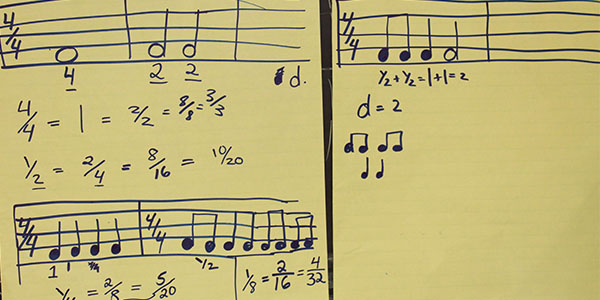
Although Arianna is listed in the Young Audiences’ Resource Guide as a storyteller, she is the first to dismiss traditional storytelling methods when a dance activity or a poetry-writing session better serves the subject at hand. For Arianna, arts integration is about adapting every day to fit the curriculum. It’s about bringing arts terms into the classroom and using them on a regular basis.
I saw Arianna use various dance and theatre terms during her lesson on physics. Students began by standing in mountain position–the actor’s resting position. They paired off and created physical representations of the concepts being discussed in the class: gravity, compression, and tension. While they explored different poses that communicated these concepts, the students physically connected to the importance of strong foundation and balance. Their choreographed dances helped them make abstract physics concepts concrete, and they were more eager to participate and share what they had learned by performing for one another.
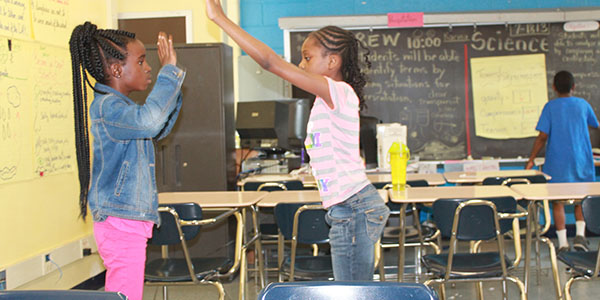
Baltimore City Public Schools Summer Learning Academies were designed to give students five weeks of additional math support during the summer. Many of these students come from low-income backgrounds and are in danger of summer learning loss, the well-studied phenomenon of students losing two to three months of math and science material learned the previous school year during the summer when intellectually engaging activities are not as readily available. As an incentive, the Baltimore City program also gives students free access to opportunities in the arts, sports, and robotics.
While the arts are an incentive for students to join the program, arts integration is doing much more than encouraging students to attend–it is helping students understand tough concepts by engaging them in new ways.
We want to hear from you!
Have you ever taken part in or led an arts-integrated activity in a classroom? Did using the arts challenge your mind to make nontraditional or creative connections in a traditional subject? Do you think the arts can help students gain agency when studying math and science?
Read more posts about Young Audiences’ summer learning programs here.
Lucy Coyle is a senior at Johns Hopkins University, majoring in International Studies, and recently completed a summer internship at Young Audiences.
The Deutsch Foundation shares its TAI experience

The Teaching Artist Institute (TAI) is made possible in partnership with Young Audiences, Arts Education in Maryland Schools Alliance (AEMS), and the Maryland State Arts Council (MSAC). TAI partners and generous sponsors, like the Robert W. Deutsch Foundation, provide funding and support that make this training opportunity accessible to all qualified artists.
Taylor DeBoer, Communications Manager for the Deutsch Foundation, joined us for the first day of the 2013 TAI Seminar retreat last week and shared his experience on the foundation’s blog. Check it out!









